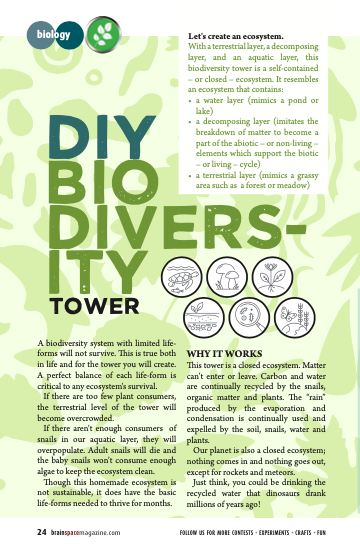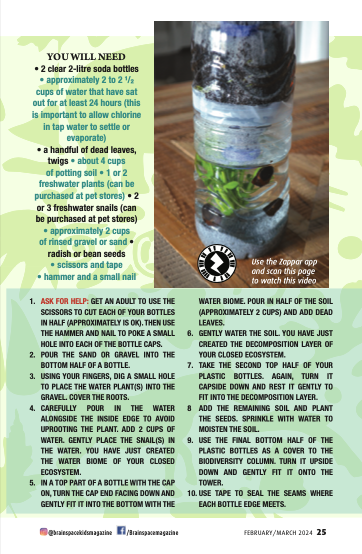
Let’s create an ecosystem.
With a terrestrial layer, a decomposing layer, and an aquatic layer, this biodiversity tower is a self-contained – or closed – ecosystem. It resembles an ecosystem that contains:
.
• a water layer (mimics a pond or lake)
.
• a decomposing layer (imitates the breakdown of matter to become a part of the abiotic – or non-living – elements which support the biotic – or living – cycle)
.
• a terrestrial layer (mimics a grassy area such as a forest or meadow)


A biodiversity system with limited life forms will not survive. This is true both in life and for the tower you will create. A perfect balance of each life form is critical to any ecosystem’s survival. If there are too few plant consumers, the terrestrial level of the tower will become overcrowded. If there aren’t enough consumers of snails in our aquatic layer, they will overpopulate. Adult snails will die and the baby snails won’t consume enough algae to keep the ecosystem clean. Though this homemade ecosystem is not sustainable, it does have the basic life forms needed to thrive for months.
.
WHY IT WORKS
This tower is a closed ecosystem. Matter can’t enter or leave. Carbon and water are continually recycled by the snails, organic matter and plants. The “rain” produced by the evaporation and condensation is continually used and expelled by the soil, snails, water and plants. Our planet is also a closed ecosystem; nothing comes in and nothing goes out, except for rockets and meteors. Just think, you could be drinking the recycled water that dinosaurs drank millions of years ago!

YOU WILL NEED
• 2 clear 2-litre soda bottles
.
• approximately 2 to 2 1/2 cups of water that have sat out for at least 24 hours (this is important to allow chlorine in tap water to settle or evaporate)
.
• a handful of dead leaves, twigs • about 4 cups
of potting soil • 1 or 2 freshwater plants (can be purchased at pet stores) • 2 or 3 freshwater snails (can be purchased at pet stores) • approximately 2 cups of rinsed gravel or sand • radish or bean seeds
.
• scissors and tape
.
• hammer and a small nail
-
ASK FOR HELP: GET AN ADULT TO USE THE SCISSORS TO CUT EACH OF YOUR BOTTLES IN HALF (APPROXIMATELY IS OK). THEN USE THE HAMMER AND NAIL TO POKE A SMALL HOLE INTO EACH OF THE BOTTLE CAPS.
. -
POUR THE SAND OR GRAVEL INTO THE BOTTOM HALF OF A BOTTLE.
. -
USING YOUR FINGERS, DIG A SMALL HOLE TO PLACE THE WATER PLANT(S) INTO THE GRAVEL. COVER THE ROOTS.
. -
CAREFULLY POUR IN THE WATER ALONGSIDE THE INSIDE EDGE TO AVOID UPROOTING THE PLANT. ADD 2 CUPS OF WATER. GENTLY PLACE THE SNAIL(S) IN THE WATER. YOU HAVE JUST CREATED THE WATER BIOME OF YOUR CLOSED ECOSYSTEM.
. -
IN THE TOP PART OF A BOTTLE WITH THE CAP ON, TURN THE CAP END FACING DOWN AND GENTLY FIT IT INTO THE BOTTOM WITH THE WATER BIOME. POUR IN HALF OF THE SOIL (APPROXIMATELY 2 CUPS) AND ADD DEAD LEAVES.
. -
GENTLY WATER THE SOIL. YOU HAVE JUST CREATED THE DECOMPOSITION LAYER OF YOUR CLOSED ECOSYSTEM.
. -
TAKE THE SECOND TOP HALF OF YOUR PLASTIC BOTTLES. AGAIN, TURN IT CAPSIDE DOWN AND REST IT GENTLY TO FIT INTO THE DECOMPOSITION LAYER.
. -
ADD THE REMAINING SOIL AND PLANT THE SEEDS. SPRINKLE WITH WATER TO MOISTEN THE SOIL.
. -
USE THE FINAL BOTTOM HALF OF THE PLASTIC BOTTLES AS A COVER TO THE BIODIVERSITY COLUMN. TURN IT UPSIDE DOWN AND GENTLY FIT IT ONTO THE TOWER.
. -
USE TAPE TO SEAL THE SEAMS WHERE EACH BOTTLE EDGE MEETS.
